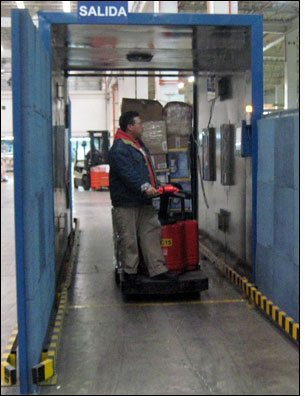Liverpool, a 76-store Mexican department store chain, is expanding its RFID-tagging program, which it rolled out in late 2007 after two years of testing. Since that time, more than 2,300 of the retailer’s suppliers have begun shipping their products in tagged plastic totes to Liverpool’s main distribution center, where the EPC Gen 2 passive ultrahigh-frequency (UHF) tags are read and used to confirm incoming shipments, as well as ready them for distribution to retail stores. Now, 200 suppliers that receive goods in single-use cardboard cartons are also tagging their shipments, thus enabling Liverpool to leverage its RFID infrastructure for all incoming products at the DC. The retailer estimates that the suppliers will apply 3 million EPC Gen 2 RFID tags to single-use cartons annually.
The distribution center ships “softline” products—any products that consumers can take home with them from a store—to all 76 Liverpool locations, explains Luis Vicente Ortega, the retailer’s dynamic response manager. Larger items, such as furniture or appliances, are handled at a separate DC, where RFID is not being used.
Most of the suppliers rent reusable logistics units (totes, pallets and other reusable containers) from Liverpool, which they use to ship product to the distribution center. By attaching RFID tags to the 600,000 logistical units in its rental pool, Liverpool was able to quickly roll out the RFID program without its suppliers having to make any changes to their business processes, and without having to invest in RFID technology. For a variety of reasons, however, 200 of the company’s suppliers do not utilize these reusable containers. These suppliers have recently begun attaching labels with embedded RFID inlays to cases of goods before they are shipped to the DC, and they also attach an RFID label to each pallet.
The labels contain UPM Raflatac ShortDipole inlays made with Impinj‘s Monza 3 chips. Mexican firm Digilogics, which acts as UPM’s tag converting partner in Mexico, embeds the inlays into the labels and employs a Zebra Technologies RZ400 RFID printer to encode a serialized shipping container code (SSCC) onto each label’s RFID chip, and to print that same number on the label in bar-code form. Grupo Hasar acted as the RFID systems integrator for the project, selecting the necessary RFID hardware and helping Liverpool to design and deploy the system. Hasar also provided the middleware required to send the shipping data from the RFID reader to the warehouse-management software used by Liverpool.
Before sending out a shipment, a supplier (whether it utilizes reusable totes or one-time-use cardboard boxes) scans the bar code on the label of each tote or box before placing that container onto a pallet. Once the pallet is fully loaded, another RFID label is placed on the pallet, and that label’s SSCC is associated with those of all totes or cases on the pallet. The supplier transmits all of this information to Liverpool in an advance shipping notice (ASN), which Liverpool then uses to confirm the order upon receipt.
According to Ortega, employees at the DC break down each pallet of goods that arrives, using Motorola handheld readers to collect the SSCC encoded to each RFID label on every case or tote. Once each pallet is broken down, the software compares the serial numbers with those on the ASN, to ensure that each pallet is complete and carries the correct goods. The cases or totes are then placed on a conveyor belt, which moves them through a tunnel. A Motorola RFID interrogator linked to an antenna mounted in the tunnel captures the serial number encoded to the tag, after which robotic arms direct each case or tote to the packing area, where it can then be packed onto a pallet with other material bound for the same retail store. Liverpool worked with Spanish company Mecalux, which develops warehouse-automation systems, to link the RFID hardware to the programmable logic controllers that direct the cases on the conveyor belt.
Once the pallets are built up and ready to send to individual stores, forklift drivers move each pallet through a tunnel, around which a Motorola interrogator creates a read zone. This collects all of the case tags and associates them with their corresponding pallet tag as a final confirmation before the pallet is placed on a truck bound for the retail store.
Liverpool has been able to realize a number of benefits from having its suppliers add RFID tags to incoming shipments at the distribution center, Ortega says. The DC is now able to process receipt of 230 cases or totes per minute—up from 60 per minute using a bar-code scanner to identify each one. And by employing RFID to validate each shipment sent from the DC to Liverpool’s stores, the percentage of wrongly shipped merchandise has fallen from 0.4 percent to 0.2 percent.
Additionally, Liverpool is working with 14 of its suppliers—including apparel company Levi Strauss—that are shipping products to the DC with RFID tags attached to individual garments or other items. At the DC, the RFID interrogators are able to read all of the item-level tags within the cases (as well as the tag attached to each case) when the cases are prepared for shipment to the retail stores. This, Ortega explains, ensures that shipments headed for the stores containing item-level-tagged merchandise are 100 percent accurate.
Inside the three Liverpool stores to which the item-level tagged merchandise is shipped, employees use handheld readers to perform monthly inventory counts. The goal is to reduce the occurrences of this merchandise falling out of stock on store shelves, as well as improve the accuracy of the store’s inventory records. According to Ortega, preliminary information from the item-level tagging pilot has shown positive results, with 99 percent inventory accuracy for tagged merchandise. What’s more, the company reports, using RFID to count inventory takes 89 percent less time than counting the items manually. As a result, the test stores perform monthly inventory counts of tagged items, while non-tagged items are counted only twice each year.


